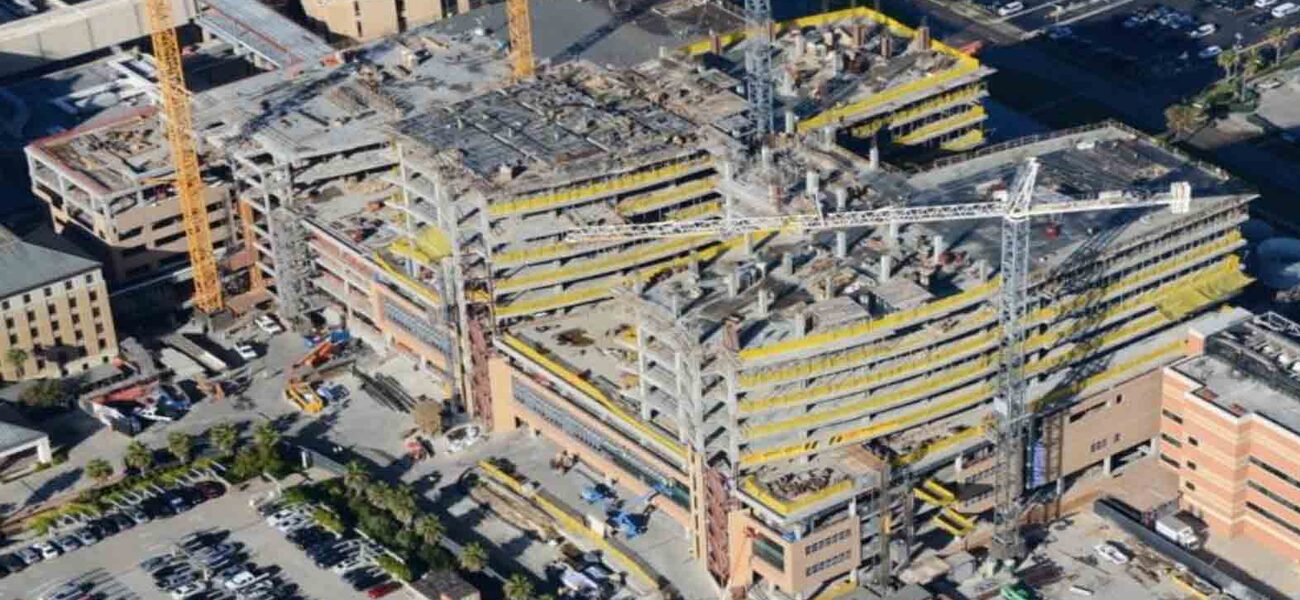The University of Texas Medical Branch (UTMB) has crafted a decision-making framework based on objective standards to identify and pursue the highest priorities in a massive building boom that has roughly 95 projects valued from $10,000 to $450 million currently under construction. While a large part of that activity stems from the university’s long-range master plan, a significant portion was necessitated by the devastation of Hurricane Ike, which took 1.2 million sf of the medical school’s Galveston campus out of service in 2008.
With the combined pressures of unprecedented growth in enrollment and patient load, along with storm mitigation, it’s essential for the medical school, the oldest west of the Mississippi, to make sure all capital investment decisions conform to its mission, vision, and strategic plan.
“Upward of a billion dollars in construction is going on right now, from our new Jennie Sealy hospital to updates like MEP mitigation in existing buildings and a district heating and cooling infrastructure upgrade for the campus,” says Gaurav Khadse, UTMB program director for healthcare planning in business operations and facilities. “With so many different needs, we cannot pick projects randomly. We have to be really prudent about where we spend our resources. All our capital investment decisions must be driven by the university’s master plan and the principles spelled out in The Road Ahead, the guiding document established by our president.”
“There are 130 departments on campus,” adds UTMB program director Bob Brown. “After the storm, many of them were moved to new locations, selected mainly according to availability. Now these departments must all be right-sized and occupying the appropriate space.”
In the university environment, putting that puzzle together requires reconciling multiple agendas, influences, and relationships. UTMB planners found the solution was to establish a regimented approach to decision-making, using three key measurement tools: space utilization, facility gap analysis, and facility condition index.
“We needed to assemble our data and metrics in a framework that would allow us to put our point across while helping to avoid politics and obtain buy-in,” explains Khadse.
Framework Components
The decision-making framework built by the facilities group has four critical components:
- The strategic plan expressed in The Road Ahead, which was developed by executives and has buy-in from all key stakeholders on campus.
- The collection of policies that help reinforce the strategic plan.
- The Facilities Infrastructure and Steering Committee, a high-level team of executive leadership chaired by the president. The steering committee is charged with reviewing and making recommendations based on the university’s strategic plan, mission, and vision. In addition to presenting final recommendations to the president, it reviews and recommends approval of appropriate related policies and projects over $10,000, and all real estate transactions and requests for space on the ground floor, a filter designed to mitigate critical functions and minimize the damage from future storms. “The steering committee provides for timely decisions on critical issues at the executive level,” says Brown. “At UTMB this is an important piece of the framework.”
- Data.
The Data, Part 1: Facility Gap Analysis
Space data is a critical component of the decision-making framework.
To enable executive-level decision-makers to evaluate and prioritize, planners developed a system to gather hard data, starting with the facilities gap analysis. This step measures each department’s existing occupied space against standards for comparable facilities.
Planners tabulated the total space occupied by each department on campus, then analyzed the results to determine what space requirements would be if “built from scratch in a brand-new facility,” says Khadse. There was no single benchmark standard to apply to all department types—including academic, research, and patient care—so the data analysis was modified to take the individual functions into account.
“To come up with the right number for UTMB, we looked at recent projects that were successful and then triangulated with others in the nation to see where we were on the curve,” explains Khadse.
The difference between the actual and desired numbers—the facilities gap—provided a quick snapshot of which departments had excess space and which were constrained.
Then departmental growth projections, based on forecasted models of, for example, research funding or patient volumes, were factored into the equation to produce a five-year gap.
“We interviewed department chairs and got their idea of what their growth would be,” says Khadse. “After executive review, those numbers were then incorporated into the action plans.”
Interestingly, the space goals of many departments filled in their space gaps five years out through planned expansion. However, the space needs of some of the departments that were already constrained became only more acute over time.
“The facilities gap analysis gave us a good footprint to start understanding the space utilization according to benchmarks,” Brown says. “We were able to see where the departments are today, where they will be five years from now, and where they should be in terms of space.”
The Data, Part 2: The Facilities Condition Index
Along with growth projections, all department spaces were evaluated by UTMB’s professional maintenance personnel from a deferred maintenance perspective. That analysis produced the facilities condition index (FCI), which is essentially the deferred maintenance value divided by the current replacement value of the building. On a scale of 0 to 1, the closer the FCI is to 1, the closer the building is to the end of its useful life.
“The FCI in our organization is calculated by evaluating 12 factors—MEP, specialty equipment, finishes, exterior façade, structure, etc.,” explains Khadse. “We also look at the efficiency factor of the building plan itself, basically the departmental gross versus the assignable square feet.”
To further refine the analysis, planners then merged each department’s gap analysis with its FCI to provide an accurate rating of space quantity and quality. While some departments might have sufficient or extra square footage, the condition of that space could be below UTMB standards, so there was a need to understand how the FCI of a building impacted the gap for each department.
“Incorporating the FCI into the analysis helped inform us if a department had excess space because of the sub-standard quality of space,” he says.
To get the holistic view of a department’s space in one metric, the FCI of a building was used to weight the gap of a department.
Blending all the hard data, executive leadership was able to pinpoint and prioritize the top five departments with the greatest need for improvements and capital investment. The planning team then focused on moving a capital request forward. The decisions were reviewed and recommended by the facilities steering committee to the president.
Action Plan
The facilities group subsequently developed an action plan that would fulfill several over-arching goals:
- Move departments out of buildings slated for demolition.
- Reclaim areas that were repurposed for storm recovery occupants, or that had over time become uses that were not appropriate.
- Improve adjacencies between departments to improve functionality.
- Review efficiency within the departmental spaces.
- Plan for backfill when new construction comes online.
- Relocate departments in the way of planned capital projects.
- Reclaim public areas and space to bring public amenities up to current standards.
Along with the hard data, the decision-making process had the flexibility to respond to other key campus considerations.
“If we knew that a particular department was in a building scheduled for demolition within two years, that pushed the action plan for the department into a higher priority.”
One of the five departments selected for action planning was on target in most metrics—it was right-sized and had a 0 gap score. However, because the department was going to be moved to a new building, the decision was made to include it among the top priorities to understand the space being vacated by that department and put the vacated space to the most appropriate use.
An Iterative Process
Khadse and Brown both emphasize that that the numbers at the heart of the decision-making framework are dynamic and always subject to change. To remain valid, the computations, analysis, and applications must be an iterative process.
“All that data will continuously inform the benchmarks and metrics, as well as the action plan,” says Khadse.
UTMB has decided to put data gathering on a two-year cycle, surveying at least 50 percent of departments annually for the gap analysis and focusing on five departments every year for action planning.
“The idea is that every year, we revisit the action plan, making sure it reflects current data, that it has buy-in, and that it is aligned with our strategic mission and vision,” says Brown. “Then we stay the course.”
“This framework is now the way we accomplish fact-based decision-making. It will also enhance our long-term capital planning process to improve alignment with our strategic plans,” concludes Khadse.
By Nicole Zaro Stahl
This report is based on a presentation Khadse made at Tradeline’s 2014 Conference on Strategic Facilities Planning and Management.



